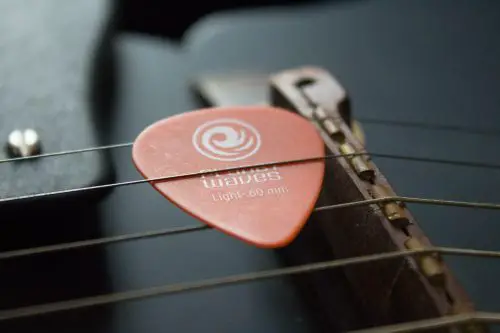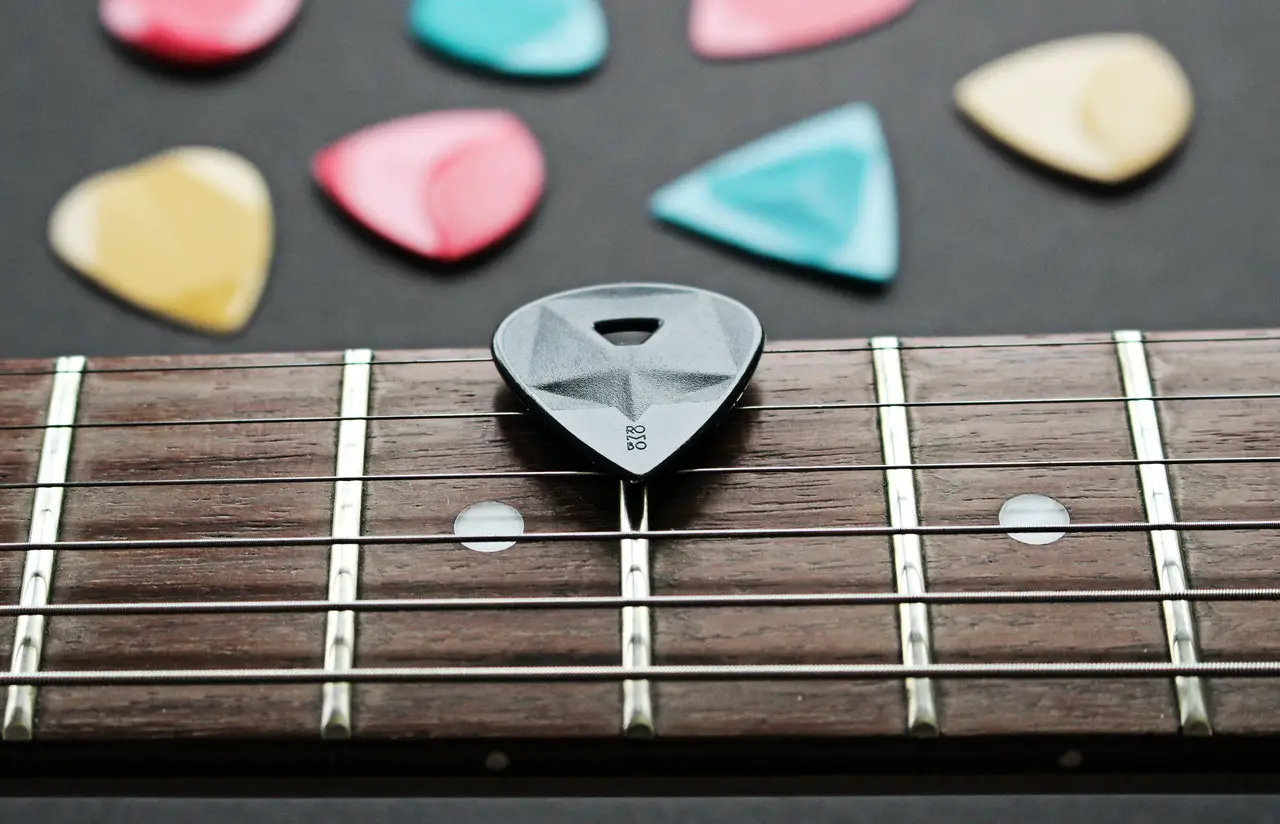Hard guitar picks give a harsher sound, while a softer one generally gives a mellow sound. Soft picks are typically used to play softly and slow. While hard picks are used to play fast (especially electric guitars).
Playing the guitar with your fingers works well for some. Still, several guitarists, especially beginners and stage performers, require a pick to get a certain level of precision and control over their guitar playing.
Guitar picks come in various shapes, sizes, and thicknesses which can significantly affect the sound produced from the strings. Some picks promote a brighter, treble sound, while others promote a bass-heavy louder sound.
Several guitarists have asked me which pick they should use, and my answer is always the same. It depends on your style. So, today I will explain the differences between various picks and help you choose one that can be an excellent fit for you.
This article will tell you about the different types of guitar picks, their thickness and materials, and which pick is better for you. Here are the topics we will cover in this article:
- What Are Things to Consider When Choosing a Guitar Pick?
- Thickness
- Material
- Shape, Size, and Texture
- Are Hard or Soft Guitar Picks Better?
- What Are Hard Guitar Picks Used For?
- What Are Soft Guitar Picks Used For?
- Which Guitar Pick Is the Best for Me?
- Which Pick Is Easier for a Beginner?
Hard Vs Soft Guitar Picks
| Hard Pick | Soft Pick | |
| Sound | Harsh | Mellow |
| Playability | Harder | Easier |
| Speed | Faster | Slower |
| Accuracy | Higher | Lower |
| Volume | Louder | Softer |
| Suitable for | Rhythm, Strumming, Acoustic | Lead, Electric |
| Thickness | > 0.75mm | < 0.75mm |
Hard Guitar Pick: Sound, Playability, Speed & Suitable Genre
Hard guitar picks produce a harsher tone when playing the guitar. They produce a wider dynamic range and are used when playing the lead electric guitar as they allow greater control and faster speed.
Harder guitar picks are often associated with harsher, bass-heavy tones. Their striking surface doesn’t bend easily, and the added force on the strings often emphasizes more bass. This means that a more accentuated sound is produced.
A hard guitar pick also gives the guitarist much more freedom on the strings as they can control the attack and the volume. These picks don’t bend as soon as they strike the strings, which eliminates that “clumsy” or “flimsy” feeling when playing.
This means that these picks can be used for faster-paced guitar playing, which is often done in rock electric guitar solos.
Generally, you can check the hardness of the pick by applying some pressure on the edge of your guitar pick with your finger. If the pick doesn’t bend too easily, you’re using a hard guitar pick. Another alternative to a hard guitar pick is to use one above 0.75mm.
Harder picks are more suitable for fast paced lead play on electric guitars. Song genres include metal, rock and jazz.
If you’re playing the lead guitar, I would recommend you to use a thicker pick as they allow you to have far better precision over your strings.

Hard and thick picks are great for fast-paced play that require accuracy. Hard picks don’t bend as easy – allowing you to accurately pick the ring strings. But it’s harder to use.
Soft Guitar Pick: Sound, Playability, Speed, Suitable Genre
Soft guitar picks produce a brighter tone when playing the guitar. They produce a tighter dynamic range and are used mainly strumming on an acoustic guitar to produce an even amount of volume.
Softer guitar picks are often associated with brighter tones. This is because the striking surface produces sounds at higher frequencies. This produces a more treble-oriented sound.
Soft guitar picks are often used for slow-paced playing, which is often associated with 12-string, acoustic and delicate guitar playing.
This is because soft picks don’t give the guitarist that much freedom over the strings as these picks can bend as they strike the strings. This can often feel clumsy, which is perfect for several musical styles.
However, soft picks are great for rhythmic and strumming play. The soft picks easily bend and can make sure all strings are hit and play out a well-rounded, even sound throughout.
You can check the hardness of your guitar pick by pinching the pick between your fingers. As this is a softer pick, it should feel more like cardboard than plastic. Softer picks generally have the same properties as thin picks, between 0.48mm to 0.60mm thick. (Usually below 0.75mm).
Soft picks are often used with more strumming required than picking. It’s difficult to play solo using a thin guitar pick as they flap around and become difficult to control.

Softer and thinner picks are great for slow paced, rhythmic and strumming play. The picks bend easily and can make sure all strings are rung equally. But you lose accuracy and cannot play fast.
Are Hard or Soft Guitar Picks Better?
There is a noticeable difference between the sounds made by hard and soft guitar picks. A hard guitar pick gives a harsher sound, while a softer guitar pick gives off a mellow sound.
It’s generally easier to play with softer guitar picks as they tend to bend a bit due to the tension in the strings. This allows much more smooth movement across the strings as they don’t tend to get ‘stuck’ between the strings, which many beginner guitarists face when using harder guitar picks.
Harder guitar picks are generally more rigid and thicker. This contributes to the loudness of the sound as harder picks typically produce a louder sound. The material of the pick also contributes to the sound.
I personally prefer a medium-weight elastic pick for most of my playing. You should try out different picks and choose one that produces the sound you like.
Things to Consider When Choosing a Guitar Pick
There are five things that you should consider before buying a guitar pick. These include thickness, hardness, texture, size, shape, and material.
These properties can significantly affect the loudness and tone of the sound produced.
1. Thickness
This is perhaps the most critical aspect in a pick that affects the sound considerably. Thicker picks are best for lead guitars, while thin picks are better for strumming.
There isn’t a universal table for the measurements, but here is a general guide:
| Thickness (millimeters) | Best for | |
| Extra Thin / Soft | <0.45mm | Rhythm |
| Thin / Soft | 0.45mm to 0.69mm | Treble / Rhythm / Acoustic |
| Medium | 0.70mm to 0.84mm | Strumming / Lead |
| Thick / Hard | 0.85mm to 1.19mm | Lead / Electric |
| Extra Thick / Hard | >1.20mm | Jazz / Metal / Electric |
2. Material
Picks can be made from several materials. Some are harder than others and can affect the sound greatly. The material also influences the durability and the feel of the pick in your hands.
Picks can be made up of celluloid, nylon, and plastics. Nylon picks are softer and provide a lot of flexibility when playing the guitar. Wood, metal, and glass are also used to make picks, but these are rare.
3. Shape, Size, and Texture
Picks come in different sizes and shapes, but the standard pick has one sharp point and looks like a teardrop with a flat surface on both sides.
Different manufacturers have their own shapes, so it’s best to test different picks to find the one you like. Different guitarists have different-sized hands, so consider this when choosing a guitar pick.
The texture doesn’t really affect the sound, but it impacts the pick’s feel in your hands.
Non-textured picks can slip out of your fingers, but they are non-obtrusive, and you won’t feel them between your fingers. Textured picks are grippier but can be a hindrance to some players.
Which Guitar Pick Is the Best for Me?
I recommend using a softer and thinner pick first and moving on to harder and thicker picks if one doesn’t suit you.
There isn’t one pick that fits all. You will need to experiment with various guitar picks of different thicknesses to find the best one for you
Picking the perfect pick for your guitar depends on how you play. If you’re a rhythm guitarist who does strumming, then you should opt for a soft pick that allows flexibility when strumming.
However, if you play the lead guitarist in a band or your style involves more fingerpicking, then you should go for a hard pick as it gives you more control and precision over the strings.
If you can’t choose between guitar picks, then going for a medium pick can be a good option for you as they allow for fingerpicking and strumming.
Which Pick Is Easier for a Beginner?
A softer pick is generally easier for beginners as it can bend across the strings and won’t get stuck in them.
Hard picks can often get stuck between the strings, which can give off an unpleasant sound and be a bit jarring for the player. Softer picks are better as beginners tend to strum rather than fingerpick the strings.
Conclusion
In my recommendation, if you’re unsure, then just opt for a medium guitar pick as it gives the best of both worlds, and then you can make a decision whether you want to get a softer or a harder guitar pick.
I hope this article helped clear any confusion you had regarding guitar picks, their thicknesses, and which one you should go for, especially if you’re a beginner guitarist.





